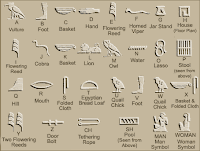Hieroglyphics. Literally, sacred carving or writing. The name was first applied to the symbolic writing of the Egyptians. It consisted largely of pictures of animals, plants, and other objects. From the inscriptions on timbers, tombs, mummy cases, etc., over 1,000 characters have been made out. They were used as we use our letters and words. The hieroglyphics are either left in relief by the cutting away of surrounding material, or they are sunk below the surface, or else they are traced, that is to say, painted, with a reed pen. Black ink, made from bone charcoal, and red mineral ink were used. When combined in writing, the animals and representations all face toward the beginning of the sentence. The reader meets them face to face, as it were. They are placed together very neatly, so as to cover a space almost as evenly as print.
There are several hundred pictures used to represent words or ideas; ideographs, they are called. For instance, the picture of a dog means dog; a woman beating a tambourine means joy; a picture of a jackal means either a jackal or cunning, according to the sense of the sentence. A wading bird indícales fishing. A precious stone of any sort is indicated by a circle or a ring; walking, by two legs. There was another method—a system of spelling by sound. It may be illustrated readily by means of the word Kleopatra. Nine pictures are required to represent the nine sounds of which the word is composed. K is represented by a picture of a knee; I, by a lion; e, by a reed; o, by a noose; p, a mat; a, an eagle; t, a hand; r, a mouth; and a, by an eagle again. To show that Kleopatra is a woman, not a man, the picture of an egg is added. The two methods are combined freely, so that a sentence may be partly pictorial, and may be spelled out in part by signs of sounds.
In later times Egyptian scholars wrote what might be called more of a running hand, in which the original pictures were not recognizable. In this connection it may be said that some of the letters in our own alphabet were originally the pictures of animals and the like. The language of the hieroglyphics, that is to say, the language of the writers in these queer characters, was spoken until the middle of the eighteenth century by the Copts, a people of Egyptian descent. The Aztec people of Mexico had a well developed system of hieroglyphics or picture writing.'
